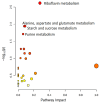Metabolic Profile of Histomonas meleagridis in Dwyer's Media with and Without Rice Starch
- PMID: 39728431
- PMCID: PMC11676859
- DOI: 10.3390/metabo14120650
Metabolic Profile of Histomonas meleagridis in Dwyer's Media with and Without Rice Starch
Abstract
Background and objectives: Histomonas meleagridis, the causative agent of histomonosis (i.e., blackhead disease), threatens the poultry industry with serious economic losses due to its high mortality and morbidity in turkey and chicken flocks. In vitro studies are complicated by the inability to culture the parasite axenically. Histomonas meleagridis has been propagated in Dwyer's media, which contains a starch source and serum, for over 50 years. The presence of insoluble starch component in Dwyer's media represents an obstacle for the commercialization of such media, and the role of starch in media is poorly understood.
Methods: To investigate the intracellular metabolomic differences in H. meleagridis and undefined bacteria grown in Dwyer's media with rice starch (SD) and without rice starch (NR), we conducted a global metabolomics analysis using ultra-high-performance liquid chromatography-high-resolution mass spectrometry.
Results: SD significantly supported the growth of H. meleagridis compared to NR. There was no significant difference in bacterial growth between SD and NR media at various timepoints. From the intracellular metabolic analysis of samples collected from the SD and NR media, a total of 170 known metabolites were identified. H. meleagridis appears to be the major contributor to global metabolic differences.
Conclusions: We found that riboflavin had the highest variable importance in the projection score, and metabolites involved in riboflavin biosynthesis significantly contributed to the differences between SD and NR in the media immediately after the inoculation of H. meleagridis and undefined bacteria, warranting further investigations into the role of riboflavin biosynthesis in H. meleagridis growth.
Keywords: Histomonas meleagridis; mass spectrometry; metabolomics; protozoa propagation; riboflavin.
Conflict of interest statement
The authors declare no conflicts of interest.
Figures







Similar articles
-
High yield of parasites and prolonged in vitro culture of Histomonas meleagridis.Avian Pathol. 2005 Dec;34(6):505-8. doi: 10.1080/03079450500368474. Avian Pathol. 2005. PMID: 16537167
-
Histomonas meleagridis (Protozoa: Trichomonadidae): analysis of growth requirements in vitro.J Parasitol. 2010 Feb;96(1):1-7. doi: 10.1645/GE-1985.1. J Parasitol. 2010. PMID: 19681647
-
In vitro effect of herbal products against Histomonas meleagridis.Vet Parasitol. 2008 Jun 14;154(1-2):1-7. doi: 10.1016/j.vetpar.2008.02.033. Epub 2008 Mar 6. Vet Parasitol. 2008. PMID: 18396376
-
Unravelling the Immunity of Poultry Against the Extracellular Protozoan Parasite Histomonas meleagridis Is a Cornerstone for Vaccine Development: A Review.Front Immunol. 2018 Nov 2;9:2518. doi: 10.3389/fimmu.2018.02518. eCollection 2018. Front Immunol. 2018. PMID: 30450097 Free PMC article. Review.
-
Interplay between Histomonas meleagridis and Bacteria: Mutualistic or Predator-Prey?Trends Parasitol. 2020 Mar;36(3):232-235. doi: 10.1016/j.pt.2019.12.015. Epub 2020 Jan 22. Trends Parasitol. 2020. PMID: 31982329 Review.
References
-
- McDougald L.R., Cervantes H.M., Jenkins M.C., Hess M., Beckstead R. Diseases of Poultry. John Wiley & Sons, Ltd.; Hoboken, NJ, USA: 2020. Protozoal Infections; pp. 1192–1254.
Grants and funding
LinkOut - more resources
Full Text Sources

